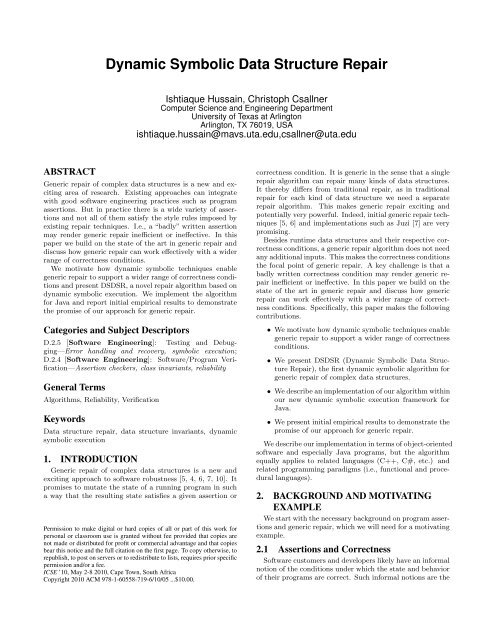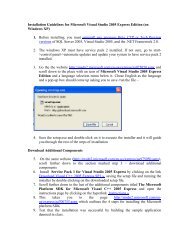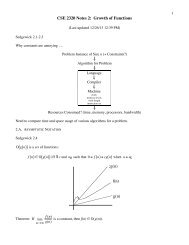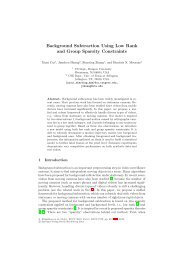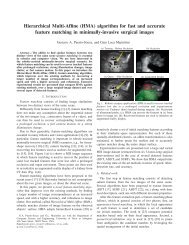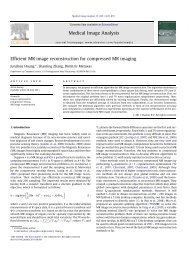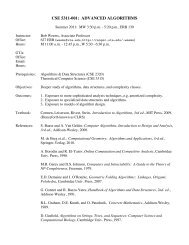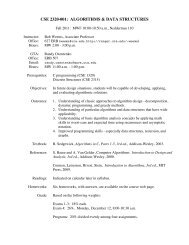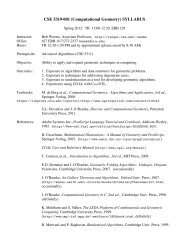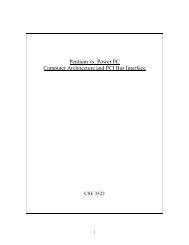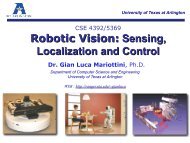PDF - Dynamic Symbolic Data Structure Repair
PDF - Dynamic Symbolic Data Structure Repair
PDF - Dynamic Symbolic Data Structure Repair
Create successful ePaper yourself
Turn your PDF publications into a flip-book with our unique Google optimized e-Paper software.
notions of program correctness that typically matter mostin real-world software applications. Large parts of softwareengineering are therefore concerned with capturing informalcorrectness notions and transforming them into more formalones, culminating in the fully formal notion of source code.This influences the terminology we use in this paper. Bycorrect we mean correct in the informal sense of the user. Acorrectness condition tries to capture this informal correctnessin a more formal notion.An easy way to write down a correctness condition is toadd to the program text a simple if-condition or programassertion. Empirical evidence suggests that programmerswrite assertions into their code and that code that containsmore assertions tends to contain fewer bugs [9].Correctness conditions may be expressed in different stylesand languages, ranging from formal modeling languages toprogram assertions. For this work, we concentrate on programassertions. Assertions are attractive as programmersdo not have to learn a separate language in order to writedown correctness conditions.The main assumption we use in this paper is that correctnessconditions have been engineered to be correct. Thisassumption is also used in all previous work we are awareof. However, we do not require the related assumption thatis often made in this area, namely that correctness conditionsalso satisfy style rules that are specific to a certainrepair technique. These rules may conflict with other concerns.Our goal is therefore to provide an approach thatdoes not depend on such repair-specific style rules.2.2 Juzi and Generic <strong>Repair</strong>Assertions are evaluated periodically as part of the programexecution, to determine if the program is still in acorrect state. If the program state is found to be incorrect,maybe due to a bug on a rarely exercised executionpath, the program is typically aborted, analyzed, fixed, redeployed,and finally restarted. But there may be situationsin which this is impossible. For example, even aborting maynot be a viable option if a program is required to keep runningto support critical services. Such scenarios are typicallyaddressed with a combination of techniques, includingredundancy and traditional, specialized repair routines. Anemerging additional technique that may be included in sucha mix is generic repair.Juzi is the state of the art approach to generic repair usingassertions [6, 7]. It builds on the Korat framework [1] andmonitors the execution of the assertion to determine theorder in which the assertion accesses data structure fields.When the assertion returns false, Juzi mutates the value ofthe field that was accessed just before the assertion failed. Ifthis does not result in a satisfactory state, Juzi backtracks inthe list of field accesses and continues with the field that theassertion has accessed earlier. Each repair attempt mutatesthe original state in one or more fields.Depending on the field type, Juzi uses different techniquesto determine candidate values. For integer fields, it employsa constraint solver, for reference fields Juzi uses the Korattechnique of skipping isomorphic structures in an otherwiseexhaustive trial and error approach.2.3 Motivating ExampleTo illustrate how our algorithm works and how it improvesupon the state of the art, we now consider the singly linkedpublic class Node {int value ;Node next ;// . .}public class L i n k e d L i s t {Node header ;// . .public boolean repOk ( ) {Node n = header ;i f ( n==null )return true ;int l e n g t h = n . value ;int count = 1 ;while ( n . next != null ) {count += 1 ;n = n . next ;i f ( count > l e n g t h )return f a l s e ;}i f ( count != l e n g t h )return f a l s e ;}}return true ;Figure 1: Example singly linked list data structure,abbreviated, consisting of a Node class and aLinkedList class. Method repOk is a contrived correctnesscondition for the linked list, which may beinvoked by assertions throughout the program.list data structure given in Figure 1. The list has a correctnesscondition, namely that the first node has a value thatis equal to the number of nodes in the list. This conditionis implemented by the repOk method, which first stores thevalue field of the first node in a temporary variable namedlength. Then the method iterates over the list nodes tocount them. This loop terminates prematurely once thenode count exceeds the value of the length variable. Thisalso prevents lists that are circular from forcing repOk intoan infinite loop. Finally, the length variable is comparedwith the node count, to produce the desired answer.(a) 45(b)(c)44Figure 2: Exhaustive approach in Juzi. Initially (a),the LinkedList is corrupt, as the first node containsvalue 4, which is incorrect according to the Figure 1repOk correctness condition. Dotted lines show thefirst three repair attempts (b, c, d). Omitted areseveral subsequent repair attempts. Ultimately repairculminates in the correct list (z).Figure 2 (a) shows an example linked list that consists of(d)(z)4535...
three nodes. The first node has a corrupt value. Accordingto the correcntess condition encoded in the Figure 1 repOkmethod, the value should be equal to the number of nodesin the list, 3, but it is off by one, 4. To repair the corruption,Juzi first (b, c, d) tries all possible mutations of thefield that the repOk method accessed last—the next pointerof the last node. Subsequently (omitted from the figure),Juzi backtracks in the list of fields accessed by the repOkmethod and continues repair actions in an exhaustive fashion.Finally, Juzi reaches a field that the repOk method hadaccessed very early, the corrupt value field of the first node,and now Juzi repairs the list successfully (z). For each repairattempt Juzi executes the repOk method, to check ifthe resulting list satisfies the repOk correctness condition.In situations like this, an exhaustive approach works wellfor repairing small data structure instances, containing fewnodes. But when repairing larger structures, at some pointexhaustive search becomes inefficient. The number of possiblemutations grows exponentially and most mutations donot result in a correct state.Our key insight is that we can guide data structure repairby mutating the data structure in such a way that the repaireddata structure takes a predetermined execution path.In our example, we want to invert the outcome of the lastif-condition such that, instead of returning false, repOk returnstrue. Indeed, if we take the path condition of theoriginal path, which returned false, invert the last conjunct,and solve the resulting path condition, we can obtain thecorrect repair action directly.3. PROPOSED APPROACH<strong>Dynamic</strong> symbolic data structure repair (DSDSR) consistsof two parts. At the lower level is a dynamic symbolicexecution engine that has a broad interface to allow modificationof path conditions, etc. Using the dynamic symbolicengine, at the top layer sits our generic repair algorithm. Inthis section we briefly describe both components.3.1 <strong>Dynamic</strong> <strong>Symbolic</strong> Execution EngineOur dynamic symbolic execution engine automatically insertsinstrumentation code into a given repOk method, whichyields an instrumented version of repOk. The execution ofthe instrumented version behaves just like the original, exceptthat it also creates a symbolic representation of theprogram execution state. In that our engine is similar toprevious ones such as Dart, jCute, and Pex [8, 12, 13]. Whenwe apply dynamic symbolic execution to repOk, we obtaina complete symbolic representation of the path taken by therepOk correctness condition. For example, we now have asymbolic representation of the last if-condition, whose concretevalue triggered repOk to return false.3.2 Algorithm for <strong>Data</strong> <strong>Structure</strong> <strong>Repair</strong>Figure 3 gives a high-level overview of our algorithm. Aspart of its normal execution, a program invokes assertionsor other methods that implement a correctness condition.In our description we follow previous work and name such amethod repOk [6, 7]. When the correctness condition fails,i.e., repOk returns false, execution is handed over to our extendeddynamic symbolic engine, which in turn invokes theinstrumented version of repOk. Executing the instrumentedrepOk builds the path condition of the execution path thatleads to the point at which repOk failed.Normal program executionRepOk returns true?NoToo many tries?No<strong>Repair</strong> AttemptI-RepOk builds path conditionModify and solve path conditionFound solution?Yes<strong>Repair</strong> data structureYesYesNoError:Failedto repairFigure 3: Overview of our dynamic symbolic datastructure repair algorithm (DSDSR). RepOk is amethod that implements a given correctness condition.I-RepOk is the instrumented version of repOk.With the full symbolic path condition in hand, we can nowmodify the path condition to obtain a different path. I.e.,if we invert the last if-condition we obtain a path that doesnot return false at the point at which the original executionfailed. At the same time, solving such a new path conditioncan give us an input state that will trigger the new path.If the new state satisfies the repOk correctness condition,we can mutate the existing state to resemble the new one,which completes the repair.The algorithm relies on a faithful encoding of the pathcondition and other program constraints in a format suitablefor automated reasoning. It further relies on a powerful automatedconstraint solver that can simplify such constraintsand, if a solution exists, can produce a concrete solution.Finally, the solution of the constraint solver needs to bemapped back into the program state, to repair the existingdata structures.We repair the data structure according to the solutionof the constraint solver and invoke repOk to check if theresulting structure satisfies the repOk correctness condition.If repOk again returns false, we may make another iterationand attempt another repair. To prevent an infinite loop ofrepair attempts, the algorithm terminates after reaching auser-defined number of futile attempts. If the repOk methodreturns true, we consider the repair attempt to be successfuland resume normal program execution.The main advantage of our approach is that, unlike Juzi,in the search for a data structure that satisfies a repOk correctnesscondition, we do not need to exhaustively generateall possible candidate data structures. Instead, DSDSR derivesconditions directly from the repOk implementation to
generate a single data structure that satisfies the correctnesscondition.3.3 ImplementationWe implement our generic repair algorithm on top of ournew dynamic symbolic execution engine for Java, called Dsc.Dsc works on top of any standard Java virtual machine. Itdoes not require modifications of the virtual machine or theuser code. This means we can repair existing Java codewhen it is executed on a standard JVM.Dsc analyzes user code at the bytecode level. It uses theinstrumentation facilities provided by Java 5 to instrumentuser code at load-time, using the ASM bytecode instrumentationframework [3, 2]. By instrumenting code at the bytecodelevel, we can repair third-party libraries that are onlyavailable in bytecode form.4. PRELIMINARY RESULTSWe conducted a small experiment using the linked listsubject of Figure 1. The experiment applies the motivatingexample of Figure 2 to lists of different lengths. Specifically,each run constructs a correct singly linked list of a givenlength, corrupts the value of the first node by increasing itby one, invokes one of the repair tools, and measures thetime the tool takes to suggest the correct repair. 1 In theexperiment both tools succeed in that they terminate withproducing the correct repair action in all cases.We conducted the experiment with the latest version ofJuzi (0.0.0.1) which we obtained from the Juzi website 2 andtook all measurements on a Sun HotSpot JVM 1.6.0 17 runningon Windows on an intel laptop 2.26GHz Core2 Duoprocessor.repair time [ms]1e+006100000100001000100JuziDSDSR100 2 4 6 8 10 12 14 16 18 20#nodesFigure 4: Result of applying the linked list exampleof Figure 2 to lists of different lengths. #nodes isthe number of nodes in the list. <strong>Repair</strong> time is thetime a tool took to produce the correct repair action.Smaller repair times are better.Figure 4 shows the result of our experiment. Juzi repairssmall lists more efficiently than our prototype implementation.But starting with 13 nodes, our approach is moreefficient. This makes sense intuitively, as an exhaustiveapproach such as Juzi is bound to be inefficient for largerdata structures, motivating more directed approaches suchas ours.1 Our prototype suggests but not yet performs a repair action.The implementation of performing a suggested repairis straightforward and will only add a negligible overhead.2 http://users.ece.utexas.edu/˜elkarabl/Juzi/index.html5. RELATED WORKGeneric data structure repair, pioneered by Demsky andRinard [5], is a relatively new area of research. Non-genericdata structure repair is not new, classic examples includethe IBM MVS/XA operating system [11].6. CONCLUSIONSOur prototype DSDSR implementation is available athttp://cseweb.uta.edu/~ishtiaqu/repair/AcknowledgmentsWe thank Bassem Elkarablieh and Sarfraz Khurshid for helpingus with Juzi.7. REFERENCES[1] C. Boyapati, S. Khurshid, and D. Marinov. Korat:Automated testing based on Java predicates. In Proc. ACMSIGSOFT International Symposium on Software Testingand Analysis (ISSTA), pages 123–133. ACM, July 2002.[2] É. Bruneton, R. Lenglet, and T. Coupaye. ASM: a codemanipulation tool to implement adaptable systems. InProc. ACM SIGOPS France Journées Composants 2002:Systèmes à composants adaptables et extensibles (Adaptableand extensible component systems), Nov. 2002.[3] G. A. Cohen, J. S. Chase, and D. L. Kaminsky. Automaticprogram transformation with Joie. In Proc. USENIXAnnual Technical Symposium, pages 167–178. USENIX,June 1998.[4] B. Demsky. <strong>Data</strong> <strong>Structure</strong> <strong>Repair</strong> Using Goal-DirectedReasoning. PhD thesis, Massachusetts Institute ofTechnology, 2006.[5] B. Demsky and M. C. Rinard. Automatic detection andrepair of errors in data structures. In Proc. 18th ACMSIGPLAN Conference on Object-Oriented Programming,Systems, Languages, and Applications (OOPSLA), pages78–95. ACM, Oct. 2003.[6] B. Elkarablieh, I. Garcia, Y. L. Suen, and S. Khurshid.Assertion-based repair of complex data structures. In Proc.22nd IEEE/ACM International Conference on AutomatedSoftware Engineering (ASE), pages 64–73. ACM, Nov.2007.[7] B. Elkarablieh and S. Khurshid. Juzi: a tool for repairingcomplex data structures. In Proc. 30th ACM/IEEEInternational Conference on Software Engineering (ICSE),pages 855–858. ACM, May 2008.[8] P. Godefroid, N. Klarlund, and K. Sen. Dart: Directedautomated random testing. In Proc. ACM SIGPLANConference on Programming Language Design andImplementation (PLDI), pages 213–223. ACM, June 2005.[9] G. Kudrjavets, N. Nagappan, and T. Ball. Assessing therelationship between software assertions and faults: Anempirical investigation. In Proc. 17th IEEE InternationalSymposium on Software Reliability Engineering (ISSRE),pages 204–212. IEEE, Nov. 2006.[10] M. Z. Malik, K. Ghori, B. Elkarablieh, and S. Khurshid. Acase for automated debugging using data structure repair.In 24th IEEE/ACM International Conference onAutomated Software Engineering (ASE). IEEE, Nov. 2009.[11] S. Mourad and D. Andrews. On the reliability of the IBMMVS/XA operating system. IEEE Transactions onSoftware Engineering (TSE), 13(10):1135–1139, Oct. 1987.[12] K. Sen and G. Agha. Cute and jCute: Concolic unit testingand explicit path model-checking tools. In Proc.International Conference on Computer Aided Verification(CAV), pages 419–423. Springer, Aug. 2006.[13] N. Tillmann and J. de Halleux. Pex - white box testgeneration for .Net. In Proc. 2nd International Conferenceon Tests And Proofs (TAP), pages 134–153. Springer, Apr.2008.


